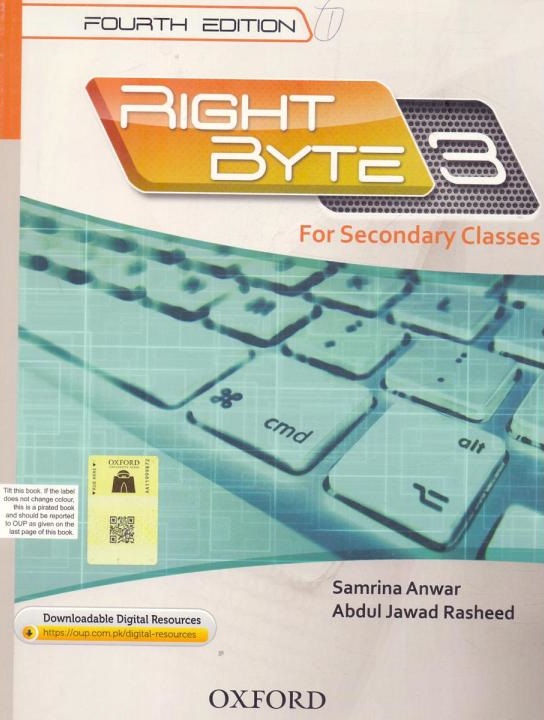Chapter 7 – Data Verification and Validation
Find accurate English-to-Urdu translations of 8th Class Chapter 7-Computer for students, helping you understand key concepts and improve comprehension. Ideal for exam preparation and language learning.
Translation English to Urdu of 8th Class Chapter 7-Computer
Chapter 7 of the Oxford Right Byte Series for 8th-grade computer studies introduces key concepts like data integrity, common types of errors, data verification, data validation, and validation checks. This chapter is fundamental in building a solid understanding of how computer systems maintain accuracy and ensure reliable data processing. In this blog, we will walk through the solved exercises for this chapter, giving you a clear understanding of these crucial topics.
Overview of Oxford Right Byte Series
The Oxford Right Byte Series is a widely recognized textbook series for teaching computer studies in schools. For 8th-grade students, Chapter 7 in this series focuses on important concepts related to computers, equipping students with essential knowledge in the digital world. If you’re studying for exams or need help with your assignments, this post will walk you through the translation English to Urdu for Chapter 7, providing you with clear and concise answers to strengthen your understanding.
What is data integrity?
The quality of output depends on the quality of input. If we start with accurate data we will get accurate information. However, we can only process a limited amount of data. We also tend to make mistakes in processing. Computers are faster and more accurate. This is why they have become so popular. However, computers are not perfect either.
آؤٹ پٹ کا معیار ان پٹ کے معیار پر منحصر ہے۔ اگر ہم درست اعداد و شمار کے ساتھ شروع کریں گے تو ہمیں درست معلومات حاصل ہوں گی۔ تاہم، ہم صرف ایک محدود مقدار میں ڈیٹا پر کارروائی کر سکتے ہیں۔ ہم پروسیسنگ میں بھی غلطیاں کرتے ہیں۔ کمپیوٹر تیز اور زیادہ درست ہیں۔ یہی وجہ ہے کہ وہ اتنے مقبول ہو گئے ہیں۔ تاہم، کمپیوٹر بھی کامل نہیں ہیں۔

While looking at your report card, you might often find errors in your marks. It might be that you were earlier shown your answer script in class that said you had scored 85% in computer studies, but your report card says you scored only 70%. Because you remember the marks that were shown to you previously, you are abv to spot the error on the report card and point it out to your teacher. But a computer cannot do this. It cannot identify such errors. We need some way of telling the computer how to sport such errors.
More Useful Links for your Study!
اپنے رپورٹ کارڈ کو دیکھتے ہوئے، آپ کو اکثر اپنے نمبروں میں غلطیاں نظر آ سکتی ہیں۔ یہ ہوسکتا ہے کہ آپ کو پہلے کلاس میں آپ کا جواب اسکرپٹ دکھایا گیا ہو جس میں کہا گیا تھا کہ آپ نے کمپیوٹر اسٹڈیز میں 85% اسکور کیے ہیں، لیکن آپ کا رپورٹ کارڈ کہتا ہے کہ آپ نے صرف 70% اسکور کیے ہیں۔ چونکہ آپ کو وہ نشان یاد ہیں جو آپ کو پہلے دکھائے گئے تھے، اس لیے آپ رپورٹ کارڈ پر موجود غلطی کو تلاش کرنے اور اسے اپنے استاد کو بتانے کے قابل ہیں۔ لیکن کمپیوٹر ایسا نہیں کر سکتا۔ یہ ایسی غلطیوں کی نشاندہی نہیں کر سکتا۔ ہمیں کمپیوٹر کو یہ بتانے کا کوئی طریقہ درکار ہے کہ ایسی غلطیوں کو کیسے کھیلا جائے۔
Sometimes the data that is entered might not make sense. If your report card says that you scored 105% in computer studies, you would know that a mistake has been made. This is because the data does not make sense. One cannot score more than 100% in any subject. The teacher has made an error in copying your marks to your report card. Again, a computer would not be able to sport such an error. We need to give it some instructions on how to identify such errors in data.
بعض اوقات جو ڈیٹا درج کیا جاتا ہے وہ معنی نہیں رکھتا۔ اگر آپ کا رپورٹ کارڈ کہتا ہے کہ آپ نے کمپیوٹر اسٹڈیز میں 105% اسکور کیے ہیں، تو آپ کو معلوم ہوگا کہ غلطی ہوئی ہے۔ اس کی وجہ یہ ہے کہ ڈیٹا کا کوئی مطلب نہیں ہے۔ کوئی کسی بھی مضمون میں 100% سے زیادہ نمبر نہیں لے سکتا۔ استاد نے آپ کے نمبر آپ کے رپورٹ کارڈ میں کاپی کرنے میں غلطی کی ہے۔ ایک بار پھر، ایک کمپیوٹر ایسی غلطی کو کھیل نہیں سکے گا۔ ہمیں اسے کچھ ہدایات دینے کی ضرورت ہے کہ ڈیٹا میں ایسی غلطیوں کی شناخت کیسے کی جائے۔
Data that is complete, accurate, and sensible has integrity. Incomplete data can lead to wrong results. If you leave out your marks on any one subject when calculating your average percentage, your data would be incomplete. As a result, the average percentage you calculate would be very different from your true average percentage.
مکمل، درست اور سمجھدار ڈیٹا کی سالمیت ہوتی ہے۔ نامکمل ڈیٹا غلط نتائج کا باعث بن سکتا ہے۔ اگر آپ اپنے اوسط فیصد کا حساب لگاتے وقت کسی ایک مضمون پر اپنے نمبر چھوڑ دیتے ہیں، تو آپ کا ڈیٹا نامکمل ہوگا۔ نتیجے کے طور پر، آپ جس اوسط فیصد کا حساب لگاتے ہیں وہ آپ کے حقیقی اوسط فیصد سے بہت مختلف ہوگا۔
If you enter the wrong total of your marks, you would again end up with the wrong average percentage. The same would happen if you entered a non-sensible value such as 105% in a subject. Therefore, to obtain sound results, we should maintain data integrity. The data we input should be complete, accurate, and sensible.
اگر آپ اپنے نمبروں کا غلط کل درج کرتے ہیں، تو آپ دوبارہ غلط اوسط فیصد کے ساتھ ختم ہوجائیں گے۔ ایسا ہی ہوگا اگر آپ نے کسی مضمون میں 105% جیسی غیر سمجھدار قدر درج کی ہے۔ لهذا، صحیح نتایج حاصل کرنے کے لیے، ہمیں ڈیٹا کی سالمیت کو برقرار رکھنا چاہیے۔ ہم جو ڈیٹا داخل کرتے ہیں وہ مکمل، درست اور سمج دار ہونا چاہیے۔

Common type of errors
Data error is very common in processing. Most of the errors occur at the data entry stage. We might misread the data or type a word incorrectly. This might happen because of poor handwriting on data forms, hardware errors, and so on. We have discussed a few errors in the previous examples. We can group these errors into different categories. Doing so helps us think of ways to avoid or correct them. Let’s discuss some of the most common types of errors.
پروسیسنگ میں ڈیٹا کی خرابی بہت عام ہے۔ زیادہ تر غلطیاں ڈیٹا انٹری کے مرحلے پر ہوتی ہیں۔ ہم ڈیٹا کو غلط پڑھ سکتے ہیں یا کوئی لفظ غلط ٹائپ کر سکتے ہیں۔ ایسا ڈیٹا فارمز، ہارڈویئر کی خرابیوں وغیرہ پر ہینڈ رائٹنگ کی خرابی کی وجہ سے ہو سکتا ہے۔ ہم نے پچھلی مثالوں میں چند غلطیوں پر بات کی ہے۔ ہم ان غلطیوں کو مختلف زمروں میں گروپ کر سکتے ہیں۔ ایسا کرنے سے ہمیں ان سے بچنے یا درست کرنے کے طریقے سوچنے میں مدد ملتی ہے۔ آئیے غلطیوں کی کچھ سب سے عام اقسام پر بات کرتے ہیں۔
Typing errors
People make typing errors when using the keyboard. They might accidentally hit a wrong key resulting in a wrong word or number being entered. The word KILOBYTE might be entered as KILOBITE. Such errors are called transcription errors.
کی بورڈ استعمال کرتے وقت لوگ ٹائپنگ کی غلطیاں کرتے ہیں۔ وہ غلطی سے کسی غلط کلید کو مار سکتے ہیں جس کے نتیجے میں کوئی غلط لفظ یا نمبر درج ہو جاتا ہے۔ KILOBITE لفظ KILOBYTE کے بطور درج کیا جا سکتا ہے۔ ایسی غلطیوں کو ٹرانسکرپشن کی غلطیاں کہتے ہیں۔
Another type of error occurs when we switch the places of two letters or numbers. For example, we might enter the word COMPUTER as COMPUTER. We have mistakenly exchanged the positions of the letters R and E. Such errors are called transposing errors.
دوسری قسم کی خرابی اس وقت ہوتی ہے جب ہم دو حروف یا اعداد کی جگہوں کو تبدیل کرتے ہیں۔ مثال کے طور پر، ہم لفظ COMPUTER کو بطور COMPUTRE درج کر سکتے ہیں۔ ہم نے غلطی سے حروف R اور E کی پوزیشنز کا تبادلہ کر دیا ہے۔ ایسی غلطیوں کو ٹرانسپوزنگ ایرر کہا جاتا ہے۔
Transmission errors
Transmission errors occur when data is shared across a computer network. These errors occur because of a problem in the transmission medium or the communication device, such as a cable or a modem. We might have entered data correctly, but due to a fault in the cable or modem, the data might not have been converted accurately into a digital or an analog form. This results in poor output because the wrong data is received by the other computer.
ٹرانسمیشن کی خرابیاں اس وقت ہوتی ہیں جب ڈیٹا کو کمپیوٹر نیٹ ورک پر شیئر کیا جاتا ہے۔ یہ خرابیاں ٹرانسمیشن میڈیم یا کمیونیکیشن ڈیوائس، جیسے کیبل یا موڈیم میں کسی مسئلے کی وجہ سے ہوتی ہیں۔ ہو سکتا ہے کہ ہم نے صحیح طریقے سے ڈیٹا درج کیا ہو، لیکن کیبل یا موڈیم میں خرابی کی وجہ سے، ہو سکتا ہے ڈیٹا کو درست طریقے سے ڈیجیٹل یا اینالاگ شکل میں تبدیل نہ کیا گیا ہو۔ اس کا نتیجہ خراب آؤٹ پٹ ہوتا ہے کیونکہ دوسرے کمپیوٹر کے ذریعہ غلط ڈیٹا موصول ہوتا ہے۔
Programming errors
Some errors occur because of a problem in the program itself. Programmers are human beings. They can make mistakes. When a programmer writes a wrong instruction in a program, the computer gives a wrong result when it processes data according to the program. The computer cannot spot such errors because it is not intelligent. It simply does what it is told.
پروگرام میں ہی کسی مسئلے کی وجہ سے کچھ غلطیاں ہوتی ہیں۔ پروگرامرز انسان ہیں۔ وہ غلطیاں کر سکتے ہیں۔ جب کوئی پروگرامر کسی پروگرام میں غلط ہدایات لکھتا ہے تو کمپیوٹر پروگرام کے مطابق ڈیٹا پر کارروائی کرنے پر غلط نتیجہ دیتا ہے۔ کمپیوٹر ایسی غلطیوں کو نہیں دیکھ سکتا کیونکہ یہ ذہین نہیں ہے۔ یہ صرف وہی کرتا ہے جو اسے بتایا جاتا ہے۔
Data verification
We have identified different types of errors that affect data integrity. Recall the example where your marks (85%) were entered incorrectly (70%) on your report card. You were able to spot the error because you had seen your marks on the answer script earlier. You compared the two marks and saw that they did not match. You then concluded that the teacher might have made an error while preparing your report card. This is called data verification.
ہم نے مختلف قسم کی خرابیوں کی نشاندہی کی ہے جو ڈیٹا کی سالمیت کو متاثر کرتی ہیں۔ اس مثال کو یاد کریں جہاں آپ کے رپورٹ کارڈ پر آپ کے نمبر (85%) غلط (70%) درج کیے گئے تھے۔ آپ غلطی کو پہچاننے میں کامیاب ہوئے کیونکہ آپ نے جواب کے اسکرپٹ پر اپنے نشانات پہلے دیکھے تھے۔ آپ نے دونوں نمبروں کا موازنہ کیا اور دیکھا کہ وہ آپس میں نہیں ملتے ہیں۔ پھر آپ نے نتیجہ اخذ کیا کہ استاد نے آپ کا رپورٹ کارڈ تیار کرتے وقت غلطی کی ہو گی۔ اسے ڈیٹا کی تصدیق کہتے ہیں۔
Data verification helps us to spot any errors in the data. To verify data, we compare it as it appears in two or more places. If it appears exactly the same everywhere, we can be sure that the data is correct. We can refer to the Source document. Recall from Book 2 that the paper or document on which data is recorded at the time of data collection is called a source document.
ڈیٹا کی توثیق ہمیں ڈیٹا میں کسی بھی خامی کی نشاندہی کرنے میں مدد کرتی ہے۔ ڈیٹا کی تصدیق کرنے کے لیے، ہم اس کا موازنہ کرتے ہیں جیسا کہ یہ دو یا زیادہ جگہوں پر ظاہر ہوتا ہے۔ اگر یہ ہر جگہ بالکل یکساں نظر آتا ہے، تو ہم یقین کر سکتے ہیں کہ ڈیٹا درست ہے۔ ہم ماخذ دستاویز کا حوالہ دے سکتے ہیں۔ کتاب 2 سے یاد کریں کہ ڈیٹا اکٹھا کرنے کے وقت جس کاغذ یا دستاویز پر ڈیٹا ریکارڈ کیا جاتا ہے اسے سورس دستاویز کہا جاتا ہے۔
Your answer script is a source document because your teacher first noted your marks on it after checking your answers. She then copied those marks from the answer script to the computer while preparing your report card. This is where the error took place.
آپ کا جواب اسکرپٹ ایک ماخذ دستاویز ہے کیونکہ آپ کے استاد نے سب سے پہلے آپ کے جوابات کو چیک کرنے کے بعد اس پر آپ کے نمبر نوٹ کیے تھے۔ اس کے بعد اس نے آپ کا رپورٹ کارڈ تیار کرتے وقت ان نمبروں کو جوابی اسکرپٹ سے کمپیوٹر پر کاپی کیا۔ یہ وہ جگہ ہے جہاں غلطی ہوئی ہے۔
If the computer knew what the marks on your answer script were, it could point out to your teacher that she was making an error. Unfortunately, it cannot verify data in this way How then can we help the computer to verify data?
اگر کمپیوٹر جانتا ہے کہ آپ کے جواب کے اسکرپٹ پر کیا نمبر ہیں، تو یہ آپ کے استاد کو بتا سکتا ہے کہ وہ غلطی کر رہی ہے۔ بدقسمتی سے، یہ اس طرح ڈیٹا کی تصدیق نہیں کر سکتا تو پھر ہم ڈیٹا کی تصدیق میں کمپیوٹر کی مدد کیسے کر سکتے ہیں؟
The double-entry method
The double-entry method of data verification is very simple. To verify data, the computer simply asks us to enter an item of data twice. By doing so, the computer can compare the two items of data. If they are identical, it means that the data has been entered correctly. The data has been verified. The computer can then start processing the data.
ڈیٹا کی تصدیق کا ڈبل انٹری کا طریقہ بہت آسان ہے۔ ڈیٹا کی تصدیق کرنے کے لیے، کمپیوٹر صرف ہم سے ڈیٹا کی ایک آئٹم کو دو بار درج کرنے کو کہتا ہے۔ ایسا کرنے سے، کمپیوٹر ڈیٹا کی دو اشیاء کا موازنہ کر سکتا ہے۔ اگر وہ ایک جیسے ہیں، تو اس کا مطلب ہے کہ ڈیٹا صحیح طریقے سے درج کیا گیا ہے۔ ڈیٹا کی تصدیق ہو چکی ہے۔ اس کے بعد کمپیوٹر ڈیٹا پر کارروائی شروع کر سکتا ہے۔
If the two items of data do not match, the computer displays a message that the data has not been verified. This prompts the user to go back to the source document and see whether he entered the data correctly. Because the user enters the same data twice, this method of data verification is called the double-entry method.
اگر ڈیٹا کے دو آئٹمز مماثل نہیں ہیں، تو کمپیوٹر ایک پیغام دکھاتا ہے کہ ڈیٹا کی تصدیق نہیں ہوئی ہے۔ یہ صارف کو ماخذ دستاویز پر واپس جانے کا اشارہ کرتا ہے اور دیکھتا ہے کہ آیا اس نے صحیح طریقے سے ڈیٹا درج کیا ہے۔ چونکہ صارف ایک ہی ڈیٹا کو دو بار داخل کرتا ہے، اس لیے ڈیٹا کی تصدیق کے اس طریقے کو ڈبل انٹری کا طریقہ کہا جاتا ہے۔
Data validation
Once data has been entered into the computer system, it is often necessary to carry out some checks to see if it is sensible. We have already seen that verification is used to eliminate most typing errors, but it is still possible for incorrect data to get through the verification stage. This is because the data might have been correctly typed in, but incorrectly written in the first place.
ایک بار جب ڈیٹا کمپیوٹر سسٹم میں داخل ہو جاتا ہے، تو اکثر یہ دیکھنے کے لیے کچھ چیک کرنے کی ضرورت ہوتی ہے کہ آیا یہ سمجھدار ہے یا نہیں۔ ہم پہلے ہی دیکھ چکے ہیں کہ تصدیق کا استعمال زیادہ تر ٹائپنگ کی غلطیوں کو ختم کرنے کے لیے کیا جاتا ہے، لیکن پھر بھی غلط ڈیٹا کا تصدیق کے مرحلے سے گزرنا ممکن ہے۔ اس کی وجہ یہ ہے کہ ہوسکتا ہے کہ ڈیٹا کو صحیح طریقے سے ٹائپ کیا گیا ہو، لیکن پہلے جگہ غلط لکھا گیا ہو۔
Recall the example where your report card said that you had scored 105%. You were able to spot this error because you know that it is impossible to score 105%. You can only score marks within a range of 0-100%. Data validation involves checking whether data lies within a sensible range. Let’s take the example of a meter-reading form filled in by a meter reader,
وہ مثال یاد کریں جہاں آپ کے رپورٹ کارڈ میں کہا گیا تھا کہ آپ نے 105% اسکور کیا ہے۔ آپ اس غلطی کو اس لیے تلاش کرنے کے قابل تھے کیونکہ آپ جانتے ہیں کہ 105% اسکور کرنا ناممکن ہے۔ آپ صرف 0-100% کی حد میں نمبر حاصل کر سکتے ہیں۔ ڈیٹا کی توثیق میں یہ جانچنا شامل ہے کہ آیا ڈیٹا ایک سمجھدار حد کے اندر ہے۔ آئیے ایک میٹر ریڈر کے ذریعے بھرے گئے میٹر ریڈنگ فارم کی مثال لیتے ہیں،
Suppose Mr Ibrahim has his electricity meter read and the reading is 0 2 3 97. This number is entered into the computer system and used to work out how much money Mr. Ibrahim owes the electricity company.
فرض کریں کہ مسٹر ابراہیم نے اپنے بجلی کے میٹر کی ریڈنگ لی ہے اور ریڈنگ 0 2 3 97 ہے۔ یہ نمبر کمپیوٹر سسٹم میں داخل ہوتا ہے اور یہ معلوم کرنے کے لئے استعمال ہوتا ہے کہ مسٹر ابراہیم پر بجلی کمپنی کے کتنے واجبات ہیں۔
The next time his meter is read it might be 0 2 543.
اگلی بار جب اس کا میٹر پڑھا جائے گا تو یہ 0 2 543 ہو سکتا ہے۔
Suppose that the meter reader makes a mistake and enters the number 02343.
فرض کریں کہ میٹر ریڈر غلطی کرتا ہے اور نمبر 02343 داخل کرتا ہے۔
This would be the number entered on the source document. The data entry officer types in the number assuming that it is correct. Similarly, when the data is typed in again, by another person, it is verified as correct. The error has not been detected! However, when the computer comes to work out the bill it has to take away the old meter reading from the new one to find out how many units have been used. The sum is 02343-02397=-54
یہ ماخذ دستاویز پر درج کردہ نمبر ہوگا۔ ڈیٹا انٹری آفیسر نمبر میں یہ فرض کرتے ہوئے ٹائپ کرتا ہے کہ یہ درست ہے۔ اسی طرح، جب ڈیٹا کو دوبارہ ٹائپ کیا جاتا ہے، دوسرے شخص کے ذریعہ، اس کی تصدیق کی جاتی ہے کہ یہ درست ہے۔ غلطی کا پتہ نہیں چلا ہے! تاہم، جب کمپیوٹر بل پر کام کرنے کے لیے آتا ہے تو اسے نئے سے پرانے میٹر کی ریڈنگ ہٹانا پڑتی ہے تاکہ معلوم کیا جا سکے کہ کتنے یونٹ استعمال ہو چکے ہیں۔ رقم 02343-02397=-54 ہے۔
This means that Mr Ibrahim has not only used no electricity, but also given some back to the electricity company! This is obviously impossible and therefore a mistake has been made. This data is not valid. The process where the computer is used to check the data once it has been entered correctly is called data validation.
Let’s learn about the different ways in which we can validate data.
اس کا مطلب یہ ہے کہ مسٹر ابراہیم نے نہ صرف بجلی استعمال کی ہے بلکہ کچھ بجلی کمپنی کو واپس بھی دی ہے۔ یہ ظاہر ہے کہ ناممکن ہے اس لیے غلطی ہوئی ہے۔ یہ ڈیٹا درست نہیں ہے۔ وہ عمل جہاں کمپیوٹر کو ڈیٹا چیک کرنے کے لیے استعمال کیا جاتا ہے ایک بار جب یہ صحیح طریقے سے داخل ہو جاتا ہے اسے ڈیٹا کی توثیق کہا جاتا ہے۔
آئیے ان مختلف طریقوں کے بارے میں سیکھتے ہیں جن سے ہم ڈیٹا کی تصدیق کر سکتے ہیں۔
Validation checks
There are numerous validation checks which can be applied to ensure data validity. These checks can be placed at different stages of the processing cycle. This reduces the chances of invalid data being processed. Some of the important validation checks are described below:
ڈیٹا کی درستگی کو یقینی بنانے کے لیے توثیق کے متعدد چیکس ہیں جن کا اطلاق کیا جا سکتا ہے۔ یہ چیک پروسیسنگ سائیکل کے مختلف مراحل میں رکھے جا سکتے ہیں۔ اس سے غلط ڈیٹا پر کارروائی ہونے کے امکانات کم ہو جاتے ہیں۔ توثیق کے چند اہم چیک ذیل میں بیان کیے گئے ہیں:
Alphabetic and numeric checks
An alphabetic check ensures that only letters of the alphabet are entered in a field, as in the name of a person or a city.
حروف تہجی کی جانچ اس بات کو یقینی بناتی ہے کہ کسی شخص یا شہر کے نام کی طرح کسی فیلڈ میں صرف حروف تہجی کے حروف درج ہوں۔
A numeric check ensures that only numbers are entered in a field, as in a telephone number (with the exception of special characters such as the hyphen and brackets).
ایک عددی چیک اس بات کو یقینی بناتا ہے کہ کسی فیلڈ میں صرف نمبرز درج کیے گئے ہیں، جیسا کہ ٹیلی فون نمبر میں (خصوصی حروف جیسے کہ ہائفن اور بریکٹ کے استثناء کے ساتھ)۔

Consistency check
A consistency check tests the data in two or more associated fields to ensure that it is logical. For example, the delivery date of an order cannot be earlier in time than the order date.
مستقل مزاجی کی جانچ دو یا دو سے زیادہ متعلقہ فیلڈز میں ڈیٹا کی جانچ کرتی ہے تاکہ یہ یقینی بنایا جا سکے کہ یہ منطقی ہے۔ مثال کے طور پر، آرڈر کی ترسیل کی تاریخ آرڈر کی تاریخ سے پہلے نہیں ہو سکتی۔
Completeness check
A completeness check ensures that all the necessary data has been entered. For example, the Student’s Name column on an application form in an online registration system, cannot be left blank.
ایک مکمل جانچ اس بات کو یقینی بناتی ہے کہ تمام ضروری ڈیٹا داخل ہو چکا ہے۔ مثال کے طور پر، آن لائن رجسٹریشن سسٹم میں درخواست فارم پر طالب علم کے نام کے کالم کو خالی نہیں چھوڑا جا سکتا۔
Table lookup
Input data, such as a barcode, is checked against a table of all the barcodes that are used If it is not in the table, then the barcode is not valid.
ان پٹ ڈیٹا، جیسے بارکوڈ، استعمال کیے جانے والے تمام بارکوڈز کے ٹیبل کے خلاف چیک کیا جاتا ہے اگر یہ ٹیبل میں نہیں ہے، تو بارکوڈ درست نہیں ہے۔
Range check
Numbers input are checked to see if they are either too large or too small. If dates are stored in DDMMYY format, 061011 is a valid date, but 134511 is not, as 45 is not a valid month. Months must lie within the range 01 to 12.
نمبروں کے ان پٹ کو یہ دیکھنے کے لیے چیک کیا جاتا ہے کہ آیا وہ بہت بڑے ہیں یا بہت چھوٹے۔ اگر تاریخیں DDMMYY فارمیٹ میں محفوظ ہیں، 061011 ایک درست تاریخ ہے، لیکن 134511 نہیں ہے، کیونکہ 45 ایک درست مہینہ نہیں ہے۔ مہینے 01 سے 12 کے درمیان ہونے چاہئیں۔
Spelling and grammar checks
We discussed spelling and grammar checks while discussing word processors. Spelling and grammar checks are also used in other types of application software. They help the computer to check for spelling and grammatical errors so that the wrong field or name is not entered accidentally.
ورڈ پروسیسرز پر گفتگو کرتے ہوئے ہم نے ہجے اور گرامر کی جانچ پر تبادلہ خیال کیا۔ ہجے اور گرامر کی جانچ پڑتال دیگر قسم کے ایپلیکیشن سافٹ ویئر میں بھی استعمال ہوتی ہے۔ وہ کمپیوٹر کو املا اور گرامر کی غلطیوں کی جانچ کرنے میں مدد کرتے ہیں تاکہ غلط فیلڈ یا نام غلطی سے داخل نہ ہو جائے۔
It should be clear by now that data verification and data validation are two different processes. Data verification checks are placed at the earliest stage of the data-processing cycle. This helps to prevent incorrect data from entering the system. On the other hand, data validation checks can be placed at any stage of the data-processing cycle. This helps the computer to ensure that the data remains within a sensible range.
اب تک یہ واضح ہو جانا چاہیے کہ ڈیٹا کی تصدیق اور ڈیٹا کی توثیق دو مختلف عمل ہیں۔ ڈیٹا کی تصدیق کے چیک ڈیٹا پروسیسنگ سائیکل کے ابتدائی مرحلے میں رکھے جاتے ہیں۔ یہ غلط ڈیٹا کو سسٹم میں داخل ہونے سے روکنے میں مدد کرتا ہے۔ دوسری طرف، ڈیٹا کی توثیق کی جانچ کو ڈیٹا پروسیسنگ سائیکل کے کسی بھی مرحلے پر رکھا جا سکتا ہے۔ اس سے کمپیوٹر کو یہ یقینی بنانے میں مدد ملتی ہے کہ ڈیٹا ایک سمجھدار رینج کے اندر رہے۔
You should also be able to see that even if verification and validation have been carried out correctly, it is still possible to get wrong data into the computer system. This is not usually the computer’s fault, but is due to human error. This also explains how it is still possible for a computer to send out an electricity bill for Rs 1,000,000. However, it would be easy to get the computer to look at the last two or three bills and to generate an error message if the latest bill was drastically different from previous bills.
آپ کو یہ بھی دیکھنے کے قابل ہونا چاہئے کہ اگر تصدیق اور توثیق درست طریقے سے کی گئی ہے، تب بھی کمپیوٹر سسٹم میں غلط ڈیٹا کا آنا ممکن ہے۔ یہ عموماً کمپیوٹر کی غلطی نہیں ہوتی بلکہ انسانی غلطی کی وجہ سے ہوتی ہے۔ اس سے یہ بھی پتہ چلتا ہے کہ کمپیوٹر کے لیے 1,000,000 روپے میں بجلی کا بل بھیجنا اب بھی کیسے ممکن ہے۔ تاہم، کمپیوٹر کو آخری دو یا تین بلوں کو دیکھنے کے لیے اور اگر تازہ ترین بل پچھلے بلوں سے بالکل مختلف تھا تو غلطی کا پیغام دینا آسان ہوگا۔
Note:
Looking for a comprehensive solution to your computer studies exercises? We’ve got you covered! Our solved exercise, all chapters of MCQs, fill in the blanks, questions and answers, and true and false for Chapter 7 from the Oxford Right Byte Series for students, teachers, schools, and colleges who want to enhance their learning and teaching experience are now available in a convenient PDF format.
Please contact us on WhatsApp +92 333 672 2439




.jpg)



